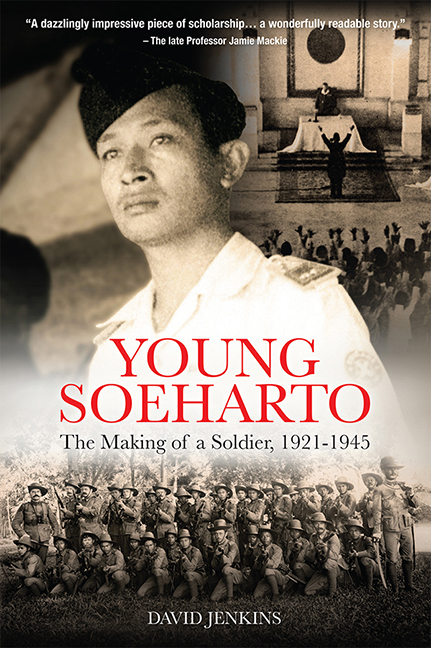Book contents
- Frontmatter
- Contents
- Foreword
- A Note on Spelling and Names
- A Note on Military Organization
- Maps
- List of Charts
- Preface
- Soeharto Family Tree
- 1 “The Sultan came to me and asked about that Family tree”
- 2 “The Cork on which the Netherlands Floats”
- 3 “They Regard Holland as a very Weak Power”
- 4 “An Invisible Motivating Force”
- 5 “What kind of Islam is this?”
- 6 “Soeharto is a Closed Book”
- 7 “I was Suited to the Disciplined life of the Military”
- 8 A Reassuringly Familiar World
- 9 A Policeman for the Japanese
- 10 An Armed Force Conjured out of Nothing
- 11 “The whole Island was Ablaze with Enthusiasm”
- 12 “Don’t make them too Strong!”
- 13 “Soeharto was a Cautious Man”
- 14 “Why did they Choose Soeharto?”
- Glossary and Abbreviations
- Notes
- Acknowledgements
- Bibliography
- Index
- About the Author
2 - “The Cork on which the Netherlands Floats”
Published online by Cambridge University Press: 09 October 2021
- Frontmatter
- Contents
- Foreword
- A Note on Spelling and Names
- A Note on Military Organization
- Maps
- List of Charts
- Preface
- Soeharto Family Tree
- 1 “The Sultan came to me and asked about that Family tree”
- 2 “The Cork on which the Netherlands Floats”
- 3 “They Regard Holland as a very Weak Power”
- 4 “An Invisible Motivating Force”
- 5 “What kind of Islam is this?”
- 6 “Soeharto is a Closed Book”
- 7 “I was Suited to the Disciplined life of the Military”
- 8 A Reassuringly Familiar World
- 9 A Policeman for the Japanese
- 10 An Armed Force Conjured out of Nothing
- 11 “The whole Island was Ablaze with Enthusiasm”
- 12 “Don’t make them too Strong!”
- 13 “Soeharto was a Cautious Man”
- 14 “Why did they Choose Soeharto?”
- Glossary and Abbreviations
- Notes
- Acknowledgements
- Bibliography
- Index
- About the Author
Summary
By virtue of his birth, the infant Soeharto was simultaneously the subject of two very different sovereigns. One was Queen Wilhelmina of Orange-Nassau, a forty-year-old Caucasian Christian, heir to an unbending Calvinist tradition, who lived half a world away, presiding over her flat and prosperous North Sea kingdom and its distant dominions, most notably the East Indies, where Dutch fortunes were thought by some to be at the high meridian of their glory. The other was Sultan Hamengku Buwono VIII, a forty-one-year-old Javanese Muslim who was not long back from the Netherlands, which, as we have seen, he had visited during his latter years as Crown Prince. The product of a distinctly non-Calvinist tradition, the Sultan was eventually to acquire not only a permaisuri (principal consort, or sultana) but seven minor wives, numerous concubines and those seventy-five children.
The Sultan lived behind the walls of the Kraton, a sprawling complex of buildings, at the centre of which stood the Golden Pavilion, where the rulers were enthroned. The Kraton was a world unto itself, somnolent and enclosed, the atmosphere languorous, the sound of gamelan music washing, gentle and percussive, over the great courtyards and walled tropical gardens. Although it had been all but powerless for ninety years, the Sultanate, and its attendant minor court, the Pakualaman, stood at the very centre of Java, both culturally and geographically. And Java was, in turn, the most populous and most important island in the Netherlands East Indies. Therein lay the seeds of so many of the problems that were to bedevil independent Indonesia. If we are to understand the world in which Soeharto came to power it is necessary to say something about the complex factors which shaped that world.
The motto of the nation that Soeharto was to rule for so long is “Unity in Diversity”. But forging a unified nation out of such extraordinary geographic, ethnic, linguistic, cultural, religious and political diversity was never going to be easy. An archipelago of more than 17,000 islands, Indonesia extends across more than one-eighth of the world's circumference at the equator, a distance of 3,400 miles from east to west and 1,200 miles from north to south.
- Type
- Chapter
- Information
- Young SoehartoThe Making of a Soldier, 1921–1945, pp. 34 - 43Publisher: ISEAS–Yusof Ishak InstitutePrint publication year: 2021

